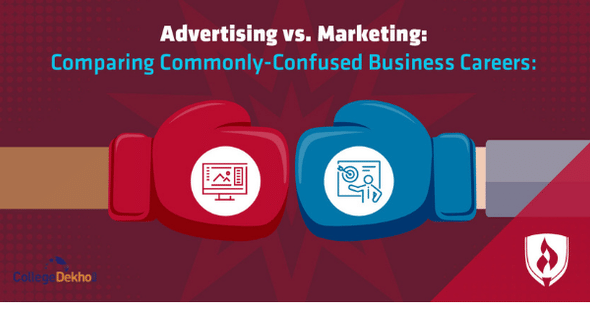Marketing and Advertisements are often confused with one another. Read the article provided to know about the differences between both terms in detail.

Modern business is continuously evolving and changing. The change in the business world has been mostly driven by technology. The implementation of technology has led businesses to employ diverse marketing and advertising strategies to increase sales and penetrate potential markets. The pervasive nature of marketing has led to marketing being spread from traditional media to digital media. The pervasive nature of marketing and advertising has been due to the effectiveness of the strategies by businesses to increase revenue and profits. Read this article to get detailed insights about Marketing vs Advertisements.
Also Read: MBA Finance vs MBA Marketing
Meaning of Marketing
The words though are used interchangeably but the words are quite different. Marketing is a much more comprehensive term compared to advertising whereas advertising is a small part of marketing. So what does the term mean? Marketing is the entire process of identifying consumer demand and guiding the production process, and finally selling the produced goods? The process of marketing does not end there; it even continues in the process of after-sales service. Thus marketing primarily focuses on the optimisation of customer satisfaction. That is how to best serve their client base while at the same time also intending to maximize revenue.
So let's have a look at the factors that influence marketing decisions.
Factors affecting Marketing Decisions
Here are some of the factors affecting marketing decisions.
- Orientation: Business orientation is the outlook of the business. One of the most important determinants of the marketing policy is the business orientation, the internal policy the objectives of the business
- Mix: The marketing mix depends on the 4Cs and the 4Ps. The 4Cs refer to the client, customer, cost, convenience, and communication. Whereas Product Price Placement Promotion is the 4Ps of the marketing mix.
- Environment: The marketing environment is dependent on both the internal and external environment. An external environment like societal conditions, market sentiments, and economic and political conditions. The internal environment refers to the company policy, internal work culture, strategy, and direction of top managers.
- Market: Target Market refers to the market segment that the company is trying to penetrate, market segment is the target demographic, the perfect clientele, and the target income group. Thus targeting and segmenting the right market helps in deciding the right marketing strategy for the business.
Also Read:MBA Finance vs MBA HR: What to Choose?
How Do You Market Products, Services, and Brands?
The marketing process involves research and analysis. By using the aforementioned process marketers use to study people and their consumption patterns to curate the products according to their needs and requirements. The marketing process also entails studying consumer behaviour, that is how they respond to existing and potential products and services. This goes a long way in devising the strategies including product development to promotional strategies. The entire process of marketing is to find out which works for the customers and implement all those in the products.
Thus an effective market helps companies to create products with the right fit to the market demand. It also influences the promotional strategy by figuring out how to connect with the consumers in the most meaningful and effective way.
The languages and the messaging are all influenced and guided by the marketing research done. The basics of marketing strategies are dependent on the four P’s: product, place, price, and promotion. It is to be understood that none of the factors works in isolation, instead, all of the factors are related and connected in one way or another. To further elaborate on the same.
- Price: It is one of the biggest determinants of the success of the product. Most consumers are very price sensitive and also the market forces of demand and supply are mostly dependent on the price of the goods only so it is very important to set the right prices. Now the pricing strategy is also dependent on a lot of factors. The first factor that influences price is the cost of the goods. So the marketing strategy also needs to help in the process of product development in a way that the cost of production is under desirable levels. So that an effective pricing strategy can be implemented. The pricing of a product is also a lot dependent on the strategy and the aim of the business. A business can have different goals for its operation; it might be profit maximization, sales maximization, or market capture. Thus the pricing strategy needs to be by all the involved factors.
- Product: The second important factor which the marketing strategy needs to decide on is product-related decisions. The marketing decisions need to guide product-related decisions. The product is developed according to the needs and demands of the customers. The products are thus to be developed to best satisfy the demands and the customers. So the marketing strategy needs to be guiding the product development.
- Placement: Every Product has some placement strategy that is under which category the product is to be launched. What would be its competitors, and which would be the product dimension? What would be the targeted customer, and what demographics to be targeted. Thus the product placement decisions are to be taken by the marketing teams.
- Promotion: The marketing strategy also needs to decide upon the Promotion Strategy of the business. Businesses need to decide upon the promotional strategies to be implemented for business growth. The strategies are to be devised by understanding consumer behaviour. The understanding of consumer behaviour helps in designing promotional strategies.
Also Read:Advertising Courses in India
What is Advertising?
Advertising is a business activity under which the company pays to propagate its messaging or branding in the market. Businesses know they need to bring out their product information and details to the customers to increase their sales. The principal goal of any business is to increase customer acquisition thus increasing revenues and sales.
Advertising is a one-way communication channel established by the business to the consumers. Thus total control rests with the companies over advertising as it is one-way communication. The company can direct the messaging and the brand image that it wants to portray to the customer. The objectives of advertising, are as follows but all of these objectives are only achieved if advertising is done properly. The advertising policy is determined by the marketing policy
- To educate the customers on the nature of the products and services that are being offered, the features of the products and services the prices the product details, and other intricacies.
- Convince customers of the superiority of the product in any one of the aspects whether the quantum, the quality or the price. The target of the advertisement should be to achieve any of the aforementioned objectives.
- Build and Improve customer perception of a brand, brand building is one of the primary function of the advertising process brand building and positive customer perception goes a long way in helping brands grow.
- Generate customer needs and wants for particular products, creating up demand and hype of the product is important for generating sales.
- Exhibit new applications and uses for products or services and also educate them in using those particular products and services.
- Publicize new products or services to potential customers to increase the market share and size of the product or service.
- Attract new customers to purchase products or services so that customer acquisition becomes expedited.
- Customer retention is one of the most important activities of advertising, long term growth, and stability of the business depend on customer retention.
In modern-day businesses, one of the highest costs involved in the operation of the business is the most important factor that influences operational decisions is the customer acquisition cost. Modern businesses depend a lot on managing the customer acquisition costs which is largely spent on the advertising of the products and services.
The scope of advertising has also changed like marketing, with the digital transformation that has taken place across all walks of life. The change of lifestyle of an average consumer has changed the way businesses advertise their products or services. With the prevalence of social media businesses now can target customers at any time at any place. The most commonly followed advertising forms are as follows.
- Traditional Advertising: This term refers to the advertisement in traditional media forms, which refers to advertisements in forms like print media, news broadcasts, and ads on television.
- Retail Advertising: This term refers to advertisements and product displays in retail stores. The shops are good investments for advertisements because they have a high conversion rate and also because the customer interest is high when they visit the sources.
- Online Advertising: This term refers to the placement of advertisements on websites and search engines. Common examples of online advertising include contextual ads in search engines, banners on websites, promotional videos, and sponsored content.
- Mobile Advertising: This term refers to advertisement placement through mobile phones and smartphones in the applications that are being run on mobile phones. Common examples of mobile advertising include automated dialers, banners to download apps, and click-to-call ads.
- Outdoor Advertising: This term refers to placements of advertisements on structures presented outsides, generally in areas to attract the most attention. Common examples of outdoor advertising include billboards, banners on the outside of buildings, and branded vehicles.
- Pay Per Click (PPC) Advertising: This term refers to the online placement of advertisements designed to drive traffic to a company’s website. Companies derive extensive customer data from these ads, only paying when users click on the link.
We hope this article helps you understand the difference between the two, if you want to go for admissions, you should fill out the Common Application Form.
Stay tuned to College Dekho for more updates. If you have any doubts, call us at our toll-free number 1800-572-9877

















Similar Articles
Top 10 Film Schools in India for 2024: Film Making Courses, Fees, Admission, Career Scope
Types of Journalism - Which is Right for You?
List of Mass Communication Courses after 12th: Eligibility, Top Colleges, Fees, Jobs
Top Companies That Hire Mass Communication graduates
SET BA Mass Communication 2024 Admission: Eligibility Criteria, Application Form, Exam Pattern, Fee Structure
Career Options in Film Studies Degree